Starbucks AI Personalization Assistant
A personalized mobile ordering experience that adapts to your mood, weather, and routine.
Problem Space
Problem Statement
How might we help Starbucks customers discover the right drink for this moment based on how they feel, where they are, and what they love?
Problem Background
Starbucks app users experience repetitive, static product suggestions that are not reflective of real-time user context. Drinks are often chosen out of convenience or routine, not preference. While Starbucks offers seasonal items, its app lacks an emotional or situational touch that helps customers make the best choice for the moment.
This problem exists at a time when user expectations for digital experiences have skyrocketed. Apps like Spotify, TikTok, and Amazon provide real-time, context-aware suggestions that create delight and trust. Starbucks has a loyal base of 30M+ mobile users and a powerful brand—but it’s missing the opportunity to engage them with intelligent, mood-driven personalization.
Problem Discovery & Research Insights
To validate the problem, I conducted:
- 7 in-depth interviews (students, professionals, freelancers)
- 1 user journey simulation
- 30-person survey
Key User Pain Points:
- "I always just get the same drink—it’s easier."
- "The app doesn’t get me."
- "I’d love if it could suggest based on how I’m feeling."
Supporting Data:
- 85% Want mood/weather/time-based suggestions
- 71% Open to inputting context (mood, location)
- 85% Value dynamic bundles
- 14% Currently satisfied with recs
- 100% Comfortable with AI suggestions
We also referenced secondary research:
- Global personalization tech market CAGR: 23.1%
- Starbucks competitors like Dunkin’ and McDonald’s have started ML efforts, but they lack emotional intelligence or real-time awareness
- Starbucks has the infrastructure (loyalty app, large user base) to lead in this space
Landing on the Solution
Based on the research, we built the Starbucks AI Personalization Assistant, an intelligent in-app feature that enhances decision-making through mood, weather, and behavior-based suggestions. The AI tailors drink + food combos, adapts to user patterns, and learns preferences over time.
Key Features:
- Mood Selector (e.g., 😴 Tired, 😊 Happy, ✨ Inspired)
- Surprise Me Button for habitual users
- Smart Bundling: AI suggests food pairings
- Transparent AI Labels: “Why this?” logic
- Emoji-based feedback loop
User Flows and Mockups
We created three core personas with tailored journeys:
Jamie – Student
- Use Case: Afternoon study break
- Mood: “Tired 😴” → Suggests: Triple Espresso + Banana Loaf
- Flow: Mood → AI Suggestion → Feedback → Reminders
Marcus – Commuter
- Use Case: Morning rush
- Feature: “Surprise Me” → Suggests: Nitro Cold Brew + Protein Box
- Flow: 1-Tap Reorder → Learn & Adapt
Tanya – Lifestyle Explorer
- Use Case: Creative lunch break
- Mood: “Inspired 💫” → Suggests: Lavender Latte + Lemon Loaf
- Flow: Shareable Rec → Feedback → Seasonal Rotation
Mockups include mood selection UI, home carousel with dynamic recs, and feedback system. These were built in React , Typescript
Future Steps
We plan to continue validating and enhancing the experience:
- Passive mood detection using app usage behavior
- Smart notifications based on routine & weather (e.g., "Want your Thursday favorite?")
- Integrate with voice (“Alexa, recommend my Starbucks order”)
- Experiment with in-store personalization through geofencing
Visual Asset
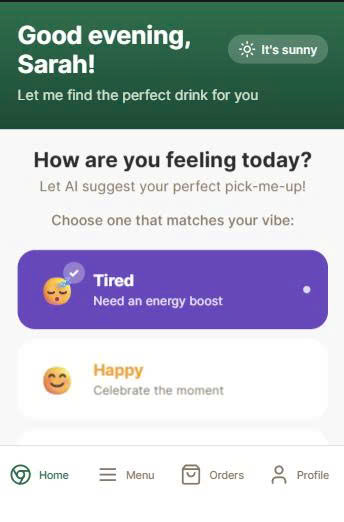
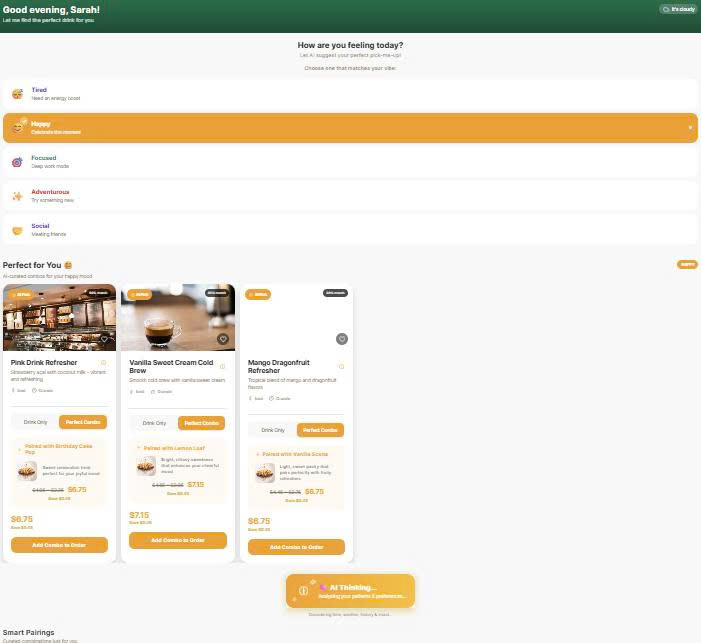
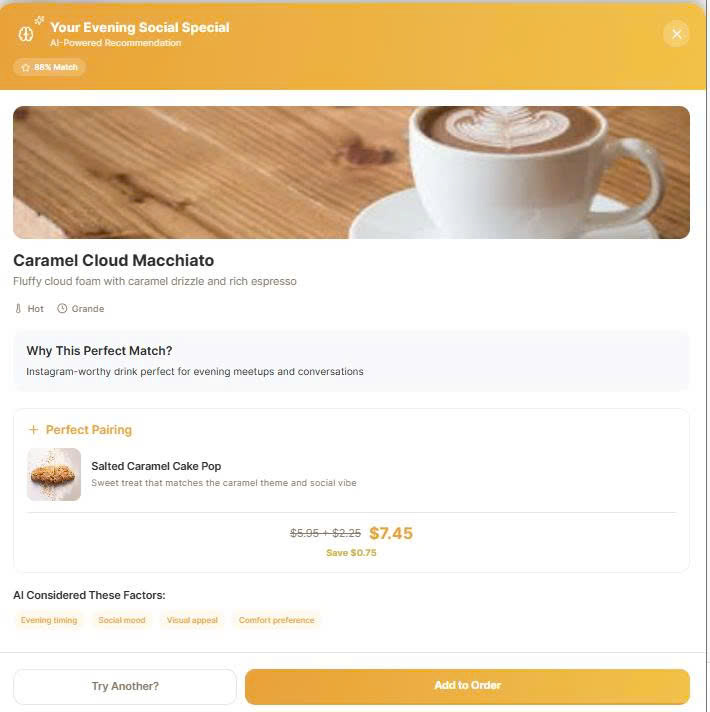
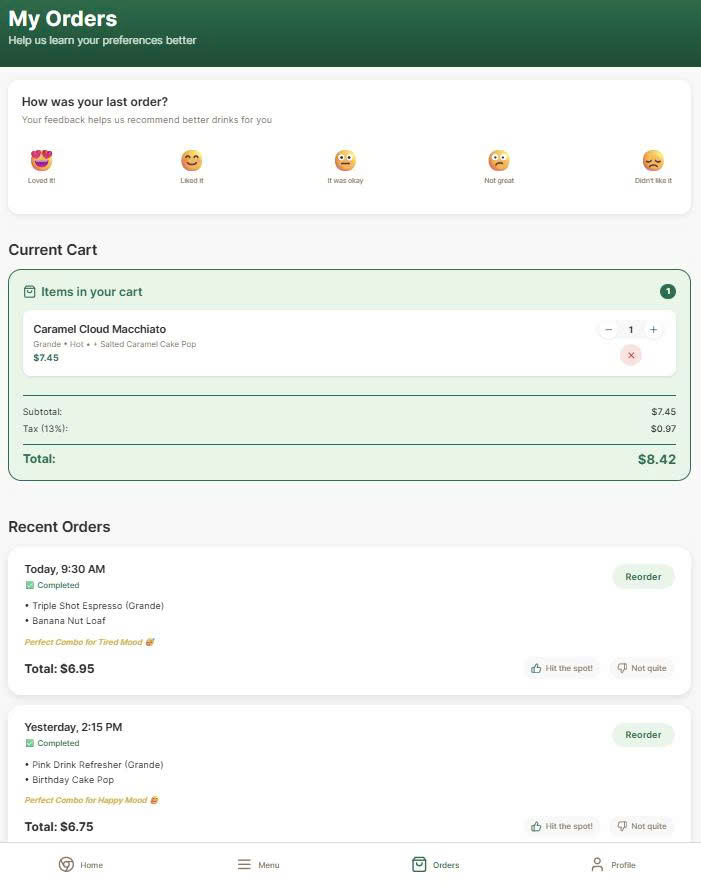
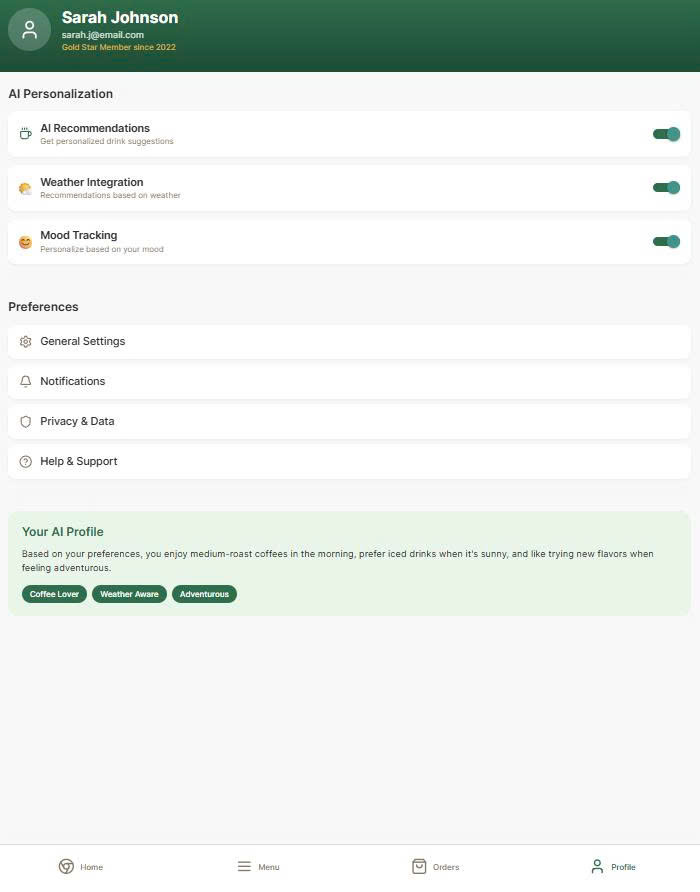
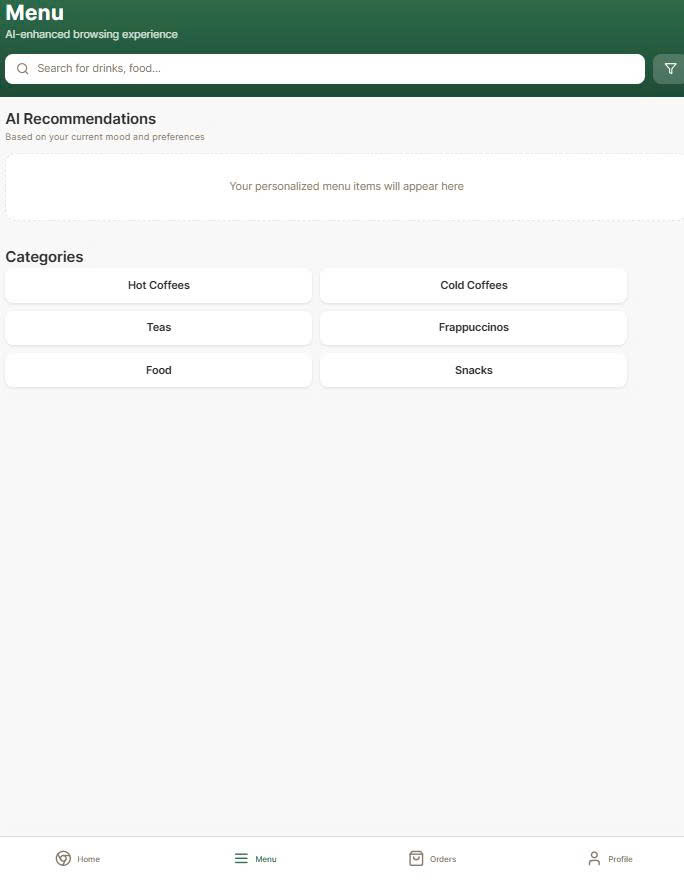

Product Manager Learnings:
Thanh (Sterling) Nguyen
This Co.Lab project enabled me to develop and apply a strong technical product management toolkit across all phases of product development. I successfully led the end-to-end process from research to MVP delivery, while deepening both strategic and executional skills.
Key Skills Demonstrated:
- Product Discovery & Research: Designed and conducted 1:1 user interviews and surveys, used affinity mapping and prioritization frameworks to identify high-value pain points.
- Go-to-Market Thinking: Defined a clear user segment, aligned with market trends, and positioned Starbucks to compete against personalization leaders like Spotify and Amazon.
- Technical Implementation:
- Integrated LLM prompts for context-aware personalization logic.
- Used n8n workflows to simulate backend recommendation flows and feedback logging.
- Explored API endpoints for time, weather, and user profile triggers to drive suggestions.
- MVP Execution:
- Wrote a full PRD with functional and non-functional requirements, success metrics, and user acceptance criteria.
- Created user flows, low-to-high fidelity wireframes, and an interactive prototype using Bolt and Figma.
- Led the design of AI-driven UX such as feedback loops, dynamic rec carousels, and “Surprise Me” functionality.
- Product Communication:
- Practiced stakeholder storytelling, wrote a structured research-backed PRD, and delivered a 5-minute recorded pitch.
- Aligned product solution with KPIs: +25% CTR, +10% AOV, and +15% retention.
This project built my confidence in leading AI-powered digital experiences. It reinforced my ability to ship thoughtful MVPs quickly, leverage modern no-code tooling, and write clear, impactful product documentation.

Designer Learnings:

Designer Learnings:
Jo Sturdivant
- Adapting to an Established Team: Joining the team in week 6 of 8 was challenging, as I had to quickly adapt to existing workflows, dynamics, and goals. This mirrors real-world situations where you often integrate into teams mid-project, and flexibility is essential.
- Work-Blocking for Efficiency: With only two weeks to complete the project, I learned the importance of a structured work-blocking system. This approach allowed me to manage my time effectively and meet deadlines under pressure.
- Making Data-Driven Design Decisions: Unlike my past projects, I had to rely on research conducted by others. This was a valuable experience in using pre-existing data to guide design decisions, helping me focus on the core insights without starting from scratch.

Developer Learnings:

Developer Learnings:
Vanady Beard
&
As the back-end developer, I learned how important it is to create efficient and reliable systems that support the entire application. This experience also taught me the importance of optimising the database and ensuring the backend is scalable and easy to maintain.

Developer Learnings:
Stephen Asiedu
&
As a back-end developer, I've come to understand the importance of being familiar with various database systems and modules. This knowledge enables me to build diverse applications and maintain versatility in my work. I've also learned that the responsibility for making the right choices rests on my shoulders, guided by my best judgement.

Developer Learnings:
&

Developer Learnings:
Maurquise Williams
&
- Process of Creating an MVP: Developing a Minimum Viable Product (MVP) taught me how to focus on delivering core functionalities balancing between essential features and avoiding scope creep.
- Collaboration in a Real-World Tech Setting: This experience taught me how to collaborate efficiently in a fast-paced tech environment, keeping the team aligned and productive, even while working remotely across time zones.
- Sharpening Critical Thinking and Problem-Solving Skills: This experience honed my ability to think critically and solve problems efficiently. By tackling challenges and finding quick solutions, I sharpened my decision-making and troubleshooting skills in a dynamic, real-world setting.

Developer Learnings:
Jeremiah Williams
&
All in all this experience was very awesome I learned that in coding with others being transparent is key

Developers Learnings:
Justin Farley
&
I learned how important communication is when working with a team. Communication provides understanding, advice, ideas, and much more. While working with the product team, I’ve found that communication keeps everything flowing smoothly. Working with a team also showed me that every member brings something different to the table and we all have to work together in order to align and meet our end goal.


